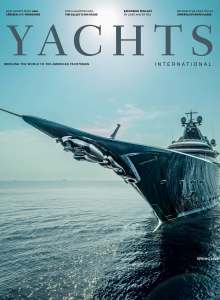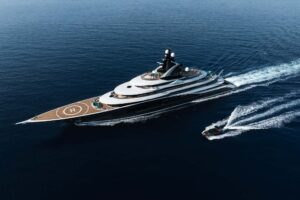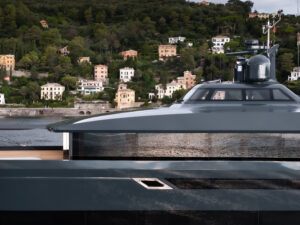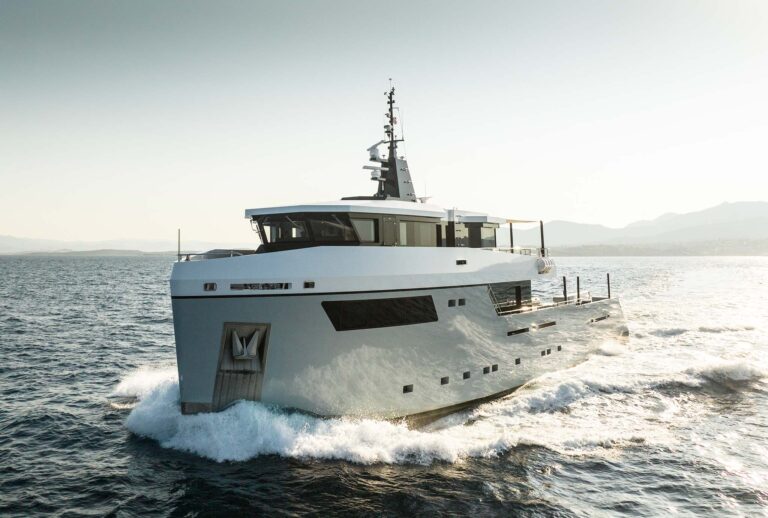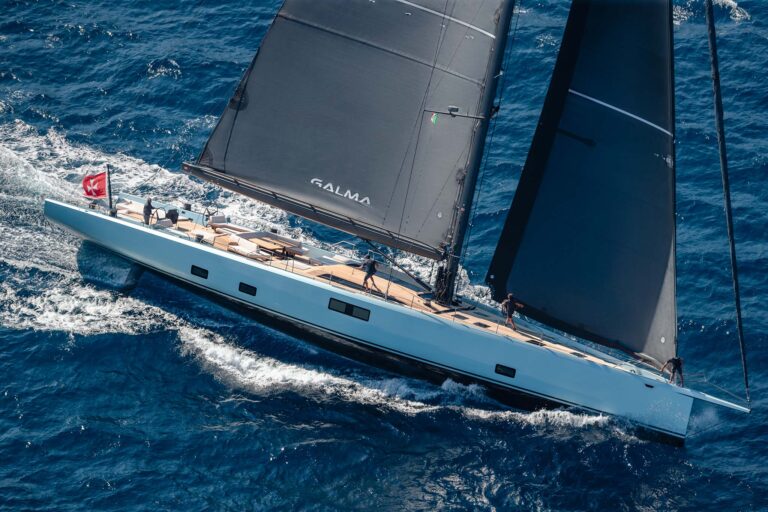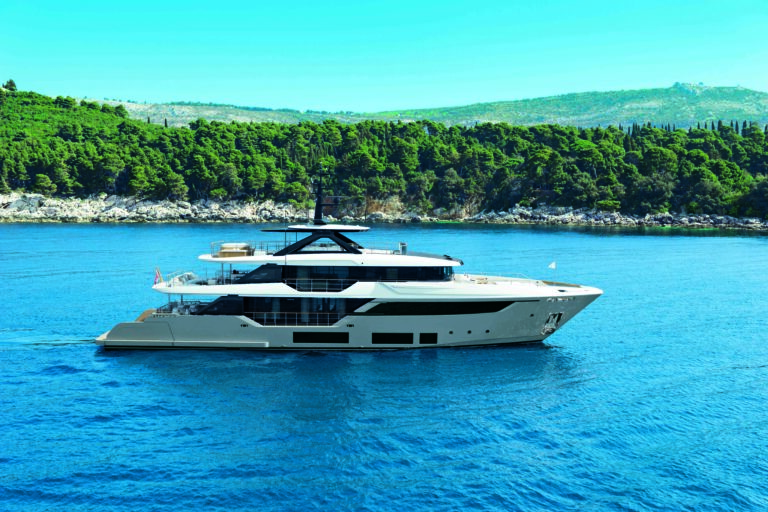Is there really such a thing as American yacht design? Some of the Western Hemisphere’s top designers plead a convincing case.
By Justin Ratcliffe

IT IS PROBABLY SAFE TO ASSUME that many Yachts International readers are able to distinguish at first glance an American production yacht from a European one, not to mention the stylistic distinctions between German, Dutch and Italian designs. But these differences become more difficult to spot when we move into full-custom territory. A discussion of American versus European yacht design naturally invites any number of subjective and sweeping generalizations. With this proviso in mind, however, it would seem there are certain design motifs that point to the nationality and cultural background of the designer, the owner or the builder—and sometimes all three.

Setzer Yacht Architects, a U.S.-based design studio with offices in Antigua, recently released sketches of a series it calls New American Motoryachts. The concepts put a new spin on designs that studio principal Ward Setzer views as distinctly American.
“The goal for the series is to freshly redefine several longstanding yacht categories that have strong American roots, but are clearly looking tired,” says Setzer. He boldly describes the series as “a vision for a new era of American custom yacht design.”

Since founding his eponymous studio 23 years ago, Setzer has collaborated with leading American brands Trinity (with at least a dozen of his designs on the water), Christensen, Delta, Broward, Intermarine, Northern Marine, Lyman Morse, Hinckley and others. He and his co-workers conceived 18 new exterior designs, ranging in size from 105 to 230 feet (32 to 70 meters), during a sabbatical in Antigua after establishing a new office in English Harbour last year.
“There is certainly a North American aesthetic,” Setzer asserts. “It is something learned the hard way with years of drawing by hand, with splines, the sheerlines of both power and sailing vessels. It is acquired by the study of the classic lines of Herreshoff or J.B. Hargrave, who I worked for as a young naval architect. It is found in the styling of classic Burgers from the early 1900s onward, the classic fantails of Henry Morgan’s vessels belonging to the New York and Palm Beach set, or the rum runners from the Prohibition era.” He also cites the influence of the American automotive industry, which is itself shaped by fashion and innovation. “Even naval and commercial vessel design and construction has played a role in shaping the look and feel of yachts,” he says.

Gregory C. Marshall, the Canadian naval architect based in Victoria, British Columbia, believes the American aesthetic has traditionally been defined by its innate conservatism. Much as Henry Ford sold cars in any color as long as it was black, most U.S. shipyards have tended to build boats in any color as long as it is white. But the issues are more than just skin deep. Marshall proposes that most American owners are driven primarily by function rather than form, with practical matters such as berthing facilities influencing the design of their yachts.
“Outside of Florida, there is generally a lack of marinas suitable for large yachts,” he says. “This means you see a lot of floating docks requiring low-level, step-off access from the boat. On the other hand, we have a lot of sheltered bays where we can anchor, so tenders need to be launched and retrieved quickly and easily. Whereas European owners like to hide tenders from view in garages for aesthetic reasons, American owners often prefer to keep their tenders on deck and launch them using cranes or davits.”
This focus on function over form carries through to the interior with traditional layouts that tend to favor simple, square spaces and fitted—as opposed to freestanding—furniture. There have been occasional attempts to remedy what might be seen as an uninspired and even pigeonholed approach to interior design. When Trinity launched the 196-foot (59.7-meter) Bacarella in 2009, for example, it was touted as proof that American yards could build European-style yachts, in part because London-based Bannenberg & Rowell came up with the interior design, which was manufactured and fitted out by Metrica in Germany.
“We’d always been accused of not being able to execute a northern European-type boat,” said John Dane III, president and CEO of Trinity Yachts, when Bacarella made her debut in Fort Lauderdale. “So with the original owner, we finally found an American who was prepared to pay the up-charge for a London designer and a European interior supplier.”
It is somewhat ironic that Dickie Bannenberg himself described the yacht as having “a Californian, natural, low-key vibe.”
What he was implying was that the interior design, although smart and chic, was still eminently livable: “You can come in wearing your swimmies and feel at home, rather than perching nervously on the edge of your seat.”
This observation had a direct impact on the 112-foot (34.1-meter) VvS1, designed by Marshall and launched by McMullen & Wing in 2007 for Kiwi owner Michael Hill. In addition to the faceted planes and vaguely military lines of the exterior styling—a look more often associated with European designs—Marshall revisited the interior layout at the owner’s request.

“He couldn’t understand why he had to come out of the water and walk dripping wet through the main salon, the most formal space on the boat, if he wanted to prepare a sandwich in the galley,” says Marshall. “This governed the position of the aft galley and the rest of the interior layout. The salon is in the middle of the yacht for use at the end of the day, while the galley and aft deck serve as a daytime space.”


Compared with other nationalities, Americans (and Australians and New Zealanders) shy away from the kind of service mentality that leads to the strict separation between crew and guest circulation. This is likely a consequence of a more relaxed and casual lifestyle, which is reflected in a preference for the country-style kitchens they often have at home. An extreme example of this is Tamsen, the 171-foot (52.1-meter) ketch launched by Perini Navi in 2007 for the Firestone family of California. The yacht has a huge galley space on the forward main deck where the extended family—children, grandchildren, aunts, uncles and cousins—can all pile into at mealtimes. “Everybody cooks and cleans,” says owner Steve Firestone. “There are a lot of kids and wet bathing suits. The design reflects that.”

Marshall refined a similar concept aboard the hugely influential Big Fish, the 147-foot (44.8-meter) expedition yacht launched by McMullen & Wing in 2010 for Englishman Richard Beattie. This time, the layout included a breakfast corner in the galley, so owner and guests could interact with the chef without getting in his way. But when the yacht was being chartered, especially with South American or Asian clients on board, the area could be closed off to function as a straightforward workstation.
Undoubtedly, there is a growing band of North American designers whose work has crossed the Atlantic divide and enjoys a truly international following. At the vanguard of this movement is Tripp Design of Norwalk, Connecticut, whose sailing superyachts built by the likes of Wally, Vitters, Baltic and most recently Arzanà Navi represent the cutting edge of sailing superyacht design. Such is the extent of Bill Tripp’s European commitments that he has opened an office in Amsterdam, where he spends at least half of his time. The modern big-boat culture does not always sit well with the more puritanical yachting mentality across the Atlantic, so it is surprising that it has taken a North American naval architect to help define some of today’s most avant-garde sailing yachts. “I find I can drink the Kool-Aid,” is Tripp’s laconic reaction.

Marshall’s 180-foot (54.8-meter) Project 6183, with its radical use of glass and asymmetric windows, has preliminary design contracts from excited European as well as American and Canadian clients. Following a positive reception of his New American Motoryachts series at the Fort Lauderdale International Boat Show, Setzer reports that he is in discussion with six major builders, only three of which are in the United States.

“I cannot speak for other American design studios, but I can say ours is simply curious about the future and grounded in the past,” Setzer says. “The key is they have to be buildable and not just sculptures on the water that do not function well in bluewater conditions. Any design house like ours has unknowingly shaped a look and feel based on the realities of actual construction limitations. These realities have combined to shape our American roots.”

